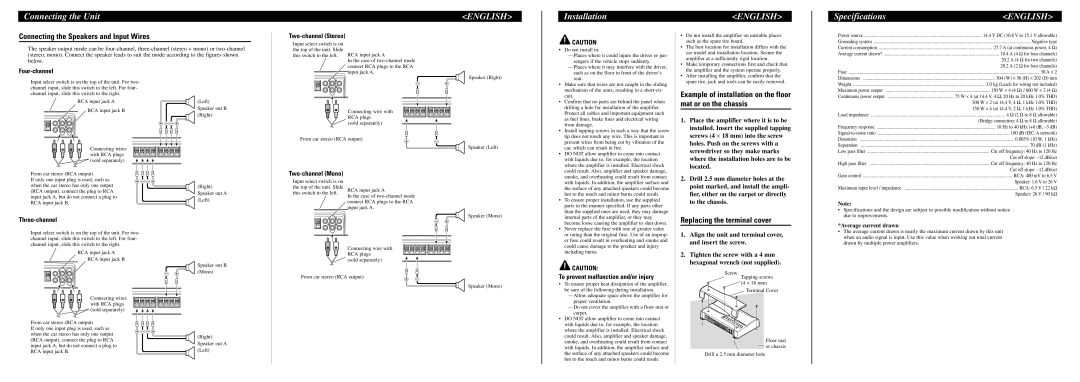PRS-D4000F specifications
The Pioneer PRS-D4000F is a high-performance car amplifier designed to enhance the audio experience in vehicles. Known for its robust construction and innovative features, this amplifier is an ideal choice for audiophiles seeking to boost their sound system's power and clarity.One of the standout characteristics of the PRS-D4000F is its impressive power output. It delivers 1,000 watts RMS at 2 ohms, ensuring that even the most demanding speakers receive the necessary power for optimal performance. With a peak power output of up to 4,000 watts, it is capable of driving multiple speakers without strain, providing a rich and immersive listening experience.
The amplifier features a Class D design, which is known for its efficiency and reduced heat production compared to traditional amplifier classes. This design allows the PRS-D4000F to maintain a compact size while still providing impressive power levels. Additionally, this efficiency means that it can be installed in a variety of spaces without worrying about excessive heat buildup, making it versatile for different vehicle types.
Another notable feature of the PRS-D4000F is its adjustable low- and high-pass filters, allowing users to tailor the sound to their preferences. The low-pass filter ensures that subwoofers receive the appropriate frequencies, while the high-pass filter prevents distortion in the midrange and high frequencies. This level of customization is particularly appealing to those who seek a specific sound signature in their audio setup.
The integrated bass boost function is another technology that enhances the performance of the PRS-D4000F. Users can easily adjust the bass output to their liking, giving them control over the low-end response. This feature is especially beneficial for users who enjoy genres of music that rely heavily on bass.
The amplifier is built with advanced thermal management technologies to ensure reliability during extended use. It boasts a robust chassis and heat sinks that keep the unit cool, even under heavy workloads. This durability is critical for ensuring longevity and consistent performance over time.
Additionally, the PRS-D4000F includes multiple protection circuits, safeguarding the amplifier from common issues such as short circuits, overheating, and overloading. This built-in protection offers peace of mind to users, allowing them to enjoy their music without the fear of damaging their equipment.
In summary, the Pioneer PRS-D4000F is an exceptional car amplifier that combines power, efficiency, and user-friendly features. Its Class D design, adjustable filters, bass boost function, and comprehensive protection systems make it a versatile choice for anyone looking to elevate their in-car audio experience. Whether for casual listening or serious audiophile applications, the PRS-D4000F stands out as a reliable and powerful component for any car audio system.

